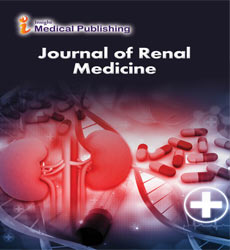The Importance of Early Detection in Renal Cell Carcinoma: Current Strategies
Senol Alberto*
Department of Urology, Virgen de la Arrixaca University Hospital, Murcia, Spain
- *Corresponding Author:
- Senol Alberto
Department of Urology, Virgen de la Arrixaca University Hospital, Murcia,
Spain,
E-mail: s.alberto@outlook.com
Received date: August 26, 2024, Manuscript No. IPJRM-24-19794; Editor assigned date: August 29, 2024, PreQC No. IPJRM-24-19794 (PQ); Reviewed date: September 12, 2024, QC No. IPJRM-24-19794; Revised date: September 19, 2024, Manuscript No. IPJRM-24-19794 (R); Published date: September 26, 2024, DOI: 10.36648/ipjrm.7.5.47
Citation: Alberto S (2024) The Importance of Early Detection in Renal Cell Carcinoma: Current Strategies. J Ren Med Vol.7 No.5: 47.
Description
Early detection of renal cell carcinoma is important for improving patient outcomes, enhancing survival rates and reducing treatment-related costs. Current strategies, including advanced imaging techniques, biomarker research and targeted screening for high-risk populations, are important components in the fight against RCC. However, challenges such as the asymptomatic nature of the disease, lack of standardized screening protocols and healthcare disparities must be addressed to improve early detection efforts. As research progresses and innovative technologies emerge, the future for enhanced early detection strategies, ultimately leading to better management and outcomes for patients with renal cell carcinoma.
The signi icance of early detection
The early stages of the disease often present with few or no symptoms, making it particularly insidious. As the tumor progresses, it may lead to a variety of symptoms such as hematuria (blood in urine), flank pain, weight loss and fatigue. Early detection of RCC significantly increases the likelihood of successful treatment and survival. This stark contrast highlights the necessity of identifying the disease before it spreads. Earlystage RCC often allows for less aggressive treatment options. Surgical intervention, such as partial nephrectomy, can be performed, preserving kidney function and reducing complications. In contrast, advanced stages may require more extensive surgery, systemic therapies, or palliative care. Early detection and treatment can reduce overall healthcare costs associated with advanced cancer treatments, including hospitalizations and emergency care for complications. Renal ultrasound is a non-invasive, cost-effective imaging modality commonly used to evaluate renal masses. While it may not provide detailed information about tumor characteristics, it is effective for initial screening. Computed Tomography (CT) Scan are more sensitive than ultrasound and can provide detailed images of kidney tumors and surrounding tissues. They are often used for staging and to guide treatment decisions. Magnetic Resonance Imaging (MRI) is particularly useful for patients with contraindications to CT It provides excellent soft tissue contrast and is helpful in characterizing renal masses. Research is ongoing to identify serum biomarkers that could aid in the early detection of RCC. For instance, elevated levels of certain proteins, such as Carbonic Anhydrase IX (CAIX) and Neuron- Specific Enolase (NSE), may indicate the presence of renal tumors. Urinary markers are being studied for their potential in early detection. For example, assays measuring urinary levels of microRNA or specific proteins may help distinguish between benign and malignant renal lesions.
Future directions in early detection
Enhanced biomarker research is continued research into biomarkers that can signal early-stage RCC will be critical. The development of reliable blood and urine tests could revolutionize early detection and make it feasible for broader populations. As artificial intelligence continues to evolve, its integration into radiology could enhance the sensitivity and specificity of imaging techniques, allowing for earlier and more accurate detection of RCC. Developing comprehensive risk stratification models that incorporate genetic, environmental and clinical factors could help identify high-risk individuals who would benefit most from early detection strategies. Empowering patients with knowledge about RCC, its symptoms and the importance of early detection can lead to more proactive healthcare-seeking behaviors. Advocacy efforts should focus on improving access to screening and imaging for high-risk populations. RCC often remains asymptomatic in its early stages, leading to late diagnoses when symptoms finally arise. This characteristic complicates screening efforts, as many patients may not seek medical attention until the disease is advanced. Unlike other cancers, such as breast or colorectal cancer, there are no standardized screening guidelines for the general population regarding RCC. This absence limits the opportunities for early detection, particularly in individuals without obvious risk factors. Access to healthcare and diagnostic imaging varies widely among different populations. Socioeconomic factors, geographic location and healthcare availability can impede early detection efforts, particularly in underserved communities. While imaging technologies like CT and MRI are effective for early detection, they can be expensive and may not be readily available to all patients, particularly in low-resource settings. Liquid biopsy, which analyzes circulating tumor DNA (ctDNA) or RNA from a blood sample, is an emerging technology with the potential for early cancer detection. While still in research phases for RCC, liquid biopsies could provide a non-invasive means to identify genetic alterations associated with early-stage disease. AI algorithms are being developed to analyze imaging data and identify subtle patterns indicative of early RCC. These technologies may improve the accuracy of early detection and help radiologists in interpreting scans.
Open Access Journals
- Aquaculture & Veterinary Science
- Chemistry & Chemical Sciences
- Clinical Sciences
- Engineering
- General Science
- Genetics & Molecular Biology
- Health Care & Nursing
- Immunology & Microbiology
- Materials Science
- Mathematics & Physics
- Medical Sciences
- Neurology & Psychiatry
- Oncology & Cancer Science
- Pharmaceutical Sciences
